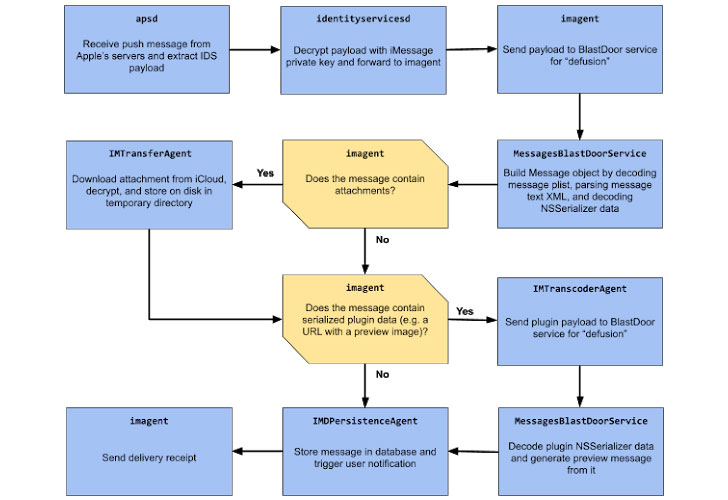Google Project Zero on Thursday disclosed details of a new security mechanism that Apple quietly added to iOS 14 as a countermeasure to prevent attacks that were recently found to leverage zero-days in its messaging app.
Dubbed “BlastDoor,” the improved sandbox system for iMessage data was disclosed by Samuel Groß, a security researcher with Project Zero, a team of security researchers at Google tasked with studying zero-day vulnerabilities in hardware and software systems.
“One of the major changes in iOS 14 is the introduction of a new, tightly sandboxed ‘BlastDoor’ service which is now responsible for almost all parsing of untrusted data in iMessages,” Groß said. “Furthermore, this service is written in Swift, a (mostly) memory safe language which makes it significantly harder to introduce classic memory corruption vulnerabilities into the code base.”
The development is a consequence of a zero-click exploit that leveraged an Apple iMessage flaw in iOS 13.5.1 to get around security protections as part of a cyberespionage campaign targeting Al Jazeera journalists last year.
“We do not believe that [the exploit] works against iOS 14 and above, which includes new security protections,” Citizen Lab researchers who revealed the attack last month.
BlastDoor forms the core of those new security protections, per Groß, who analyzed the implemented changes over the course of a week-long reverse engineering project using an M1 Mac Mini running macOS 11.1 and an iPhone XS running iOS 14.3.
When an incoming iMessage arrives, the message passes through a number of services, chief among them being the Apple Push Notification Service daemon (apsd) and a background process called imagent, which is not only responsible for decoding the message contents but also for downloading attachments (through a separate service called IMTransferAgent) and handling links to websites, before alerting the SpringBoard to display the notification.
What BlastDoor does is inspect all such inbound messages in a secure, sandboxed environment, which prevents any malicious code inside of a message from interacting with the rest of the operating system or accessing user data.
Put differently, by moving a majority of the processing tasks — i.e., decoding the message property list and creating link previews — from imagent to this new BlastDoor component, a specially-crafted message sent to a target can no longer interact with the file system or perform network operations.
“The sandbox profile is quite tight,” Groß noted. “Only a handful of local IPC services can be reached, almost all file system interaction is blocked, any interaction with IOKit drivers is forbidden, [and] outbound network access is denied.”
What’s more, in a bid to delay subsequent restarts of a crashing service, Apple has also introduced a new throttling feature in the iOS “launchd” process to limit the number of tries an attacker gets when seeking to exploit a flaw by exponentially increasing the time between two successive brute-force attempts.
“With this change, an exploit that relied on repeatedly crashing the attacked service would now likely require in the order of multiple hours to roughly half a day to complete instead of a few minutes,” Groß said.
“Overall, these changes are probably very close to the best that could’ve been done given the need for backwards compatibility, and they should have a significant impact on the security of iMessage and the platform as a whole.”


